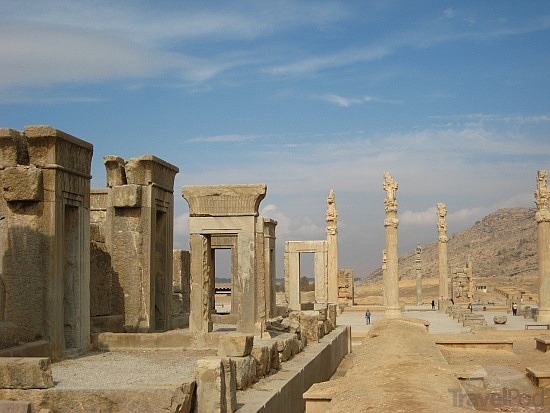The article below by the late Shapour Shahbazi on the The Palace of Xerxes (the Hadiš) was first posted on the Encyclopedia Iranica as part of a larger article on the Persepolis city-palace.
========================================================================
Xerxes’ private residence (called hadiš in one of its inscriptions) was twice the size of the Tačara and stood on a platform hewn from the natural bedrock 18 m. higher than the level of the plain. It had a thirty-six columned square hall connected by a doorway to a long balcony on the south which gave a panoramic view of the plain from behind four-stepped crenellations, by another pair to a twelve-columned portico on the north, and by two more to flanking apartments each consisting of a four-columned hall, storage and guardrooms, and a tower. The hall had also nineteen windows and four niches, each hewn from a monolith, and a complete system of drainage. Two double reversed staircases bearing sculptures similar to that of the Tačara ascended the Hadiš from the western and eastern courtyards, while two unadorned staircases on either sides of the balcony (the eastern one was restored in 1978) led down to the Harem. The fine but brittle stone used in this palace was severely burned during Alexander’s fire, making it very difficult to protect the little that has survived.
 Excellent photo of Xerxes’ palace by TravelPod Member “Skiwiman” (Source: Tripwow.Tripadvisor.com).
Excellent photo of Xerxes’ palace by TravelPod Member “Skiwiman” (Source: Tripwow.Tripadvisor.com).
The sculptures on the doorjambs of the main hall show Xerxes, wearing a tall plain cylindrical crown, and accompanied by two attendants (depicted on a much smaller scale), a parasol-holder, and a towel or a flywhisk carrier. Trilingual inscriptions carved on the folds of the royal garment and above the parasol identify the king, and similar ones are inscribed on the frames of windows and niches. The more detailed trilingual texts on the pillars of the northern portico are essentially the same as those on the pillars of the Tačara portico. In 1978 this writer discovered that an Old Persian inscription carved above the king’s parasol on the eastern jamb of the northwestern doorway of the Hadiš named the royal personage as “Darius the king” instead of “Xerxes the king” (Shahbazi, 1985, pp. 11-12, Pls. XI-XII). This proved that Xerxes had started the Hadiš while he was Darius’ co-regent. The inner faces of the windows of the Hadiš are sculptured with representations of people carrying utensils or leading wild goats or similar animals. This is a variation in Persepolitan sculptures and has no parallel elsewhere.
Bibliography
Shahbazi, Sh., Old Persian Inscriptions from PersepolisPlatform, Corp. Inscr. Iran I/1.1, London, 1985.



